
The best camera is the one you always have with you. What’s the point of an expensive, heavy DSLR camera with all its finesse if it’s just so heavy and unwieldy that you usually leave it at home? And this is exactly where the little Osmo Pocket comes into play. Here’s our review of the tiny 4K/60 FPS all-rounder.
Review: DJI Osmo Pocket
Content:
Page 1: Specs, Accessories, Activation
Page 2: How to use, Mimo App
Page 3: Pro & Cons, Rating
Page 4: Tips, Tricks und Mods
Page 5: Videos
DJI Osmo Pocket
| DJI Osmo Pocket & Accessories: |
|---|
| DJI Osmo Pocket 15% Off - Code: OSMO15 |
| ND Filter Set for Osmo Pocket |
| Osmo Pocket Tripod |
| Mini Tripod for Osmo Pocket |
| Skins / Decals for Osmo Pocket |
DJI has become well-known to many drone pilots, because this company – now worth billions – revolutionized drone technology for home users a few years ago. But it wasn’t just DJI’s drones that became more sophisticated and compact over time. In the last years DJI also focused more and more on camera technology. Today, DJI drones have the best cameras on the market – so what could be more obvious than to offer the same camera technology DJI uses in their drones as independent systems for hobby and action filmmakers?
With the Osmo Pocket you hold the complete camera system of a high tech drone in your hand – but without the drone: a simple handle with a tiny high-resolution camera at its upper end, which – just like a drone – is mounted on a joint and can therefore swivelled in all directions. It also mechanically compensates movements, jolts and shaking. And this works so well that the Osmo Pocket can be described as an “Action Cam”, because in almost every situation it can produce absolutely stable, wobble-free videos and smooth camera pans.
When you hold the pocket in your hand, you really notice how small and compact this technology has become. Hardly bigger than a cigar and only a little over 100 Grams light, the Osmo Pocket offers all the features for which you had to strap on an expensive professional camera system before:
Excellent image quality in 4k with 60 FPS and 100 Mbit/s
Automatic tracking of objects (see below)
Automatic modes, but also “Pro” manual settings available
Absolutely stable, shake-free videos – even when running, biking or skiing
Exclusive Banggood Coupon Codes
▪ For our readers we have received exclusive discount coupon codes from Banggood, with which you can save up to 25% when buying Mavic, Spark, Mini FPV Racers and accessories such as Runcam Split, FrSky XLITE, antennas, etc. You can find these coupons on our coupons page. This section is constantly updated, so check back often.
DJI Osmo Pocket Specs
| Gimbal | Axis: 3-Axis Yaw Axis: -230° to +50° Pitch Axis: -95° to +50° Roll Axis: ±45° |
| Camera | Sensor: 1/2.3″ CMOS FOV: 80 degrees Aperture: f/2.0 Resolution: 12 Megapixels Shutter Speed: 8s – 1/8000s Foto Modes: Single Shot, Panorama, Timelapse, Moving Timelapse, Slow Motion |
| Video | 4K Ultra HD: 3840×2160 24/25/30/48/50/60p Full HD: 1920×1080 24/25/30/48/50/60p Max. Video Bitrate: 100 Mbit/s Videoformats: MP4/MOV (MPEG-4 AVC/H.264) Audio: 48 KHz AAC |
| Foto | Max. Size: 4000×3000 Foto Formats: JPEG/JPEG+DNG |
| Battery | Typ: 875mAh Lipo Battery Runtime: 140 Mins Charging Time: 75 Mins Supports charging while recording |
| SD Cards | Supported: FAT32 (=32 GB), exFAT (>64 GB) microSD (max. 256 GB) |
| Size | 121,9 × 36,9 × 28,6 mm |
| Weight | 116g |
Digital VS Mechanical Stabilization
Nothing’s worse than a shaky video. Many “action cams” – and even smartphones – advertise the term “image stabilization” today, but it is usually concealed that this is only a digital stabilization. Each video frame is trimmed at the edges and then rescaled and repositioned to match the other frames. The shake is then more or less gone – but the picture quality suffers noticeably.
Mechanical stabilization, on the other hand, works differently: here the camera sits on a joint that, driven by tiny electric motors, automatically compensates for every shake many times per second. The recorded video is not trimmed or manipulated in any way, since it is the camera itself that is stabilized instead. Mechanical stabilization is therefore preferable to digital stabilization.
A mechanical 3-axis stabilization requires a “Gimbal”, i.e. cameras that sit on an electronically driven joint. And that’s what the small Osmo Pocket is. Since this technology requires a joint and moveable parts, it is obvious that smartphones cannot do this and instead have to “trick” with digital stabilization.
Accessories
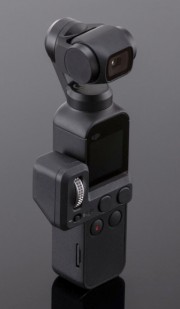
The two included USB adapters are intended for connecting the Osmo Pocket to a smartphone (with either a Lightning or an USB-C port) and are inserted into a rail at the top front of the Osmo. The Osmo Pocket can then be connected to a smartphone and controlled with the free DJI Mimo app.
So much for the basic equipment. In the DJI Store there are other accessories for the Pocket available (or announced at the time of writing), such as a control wheel, which can be attached to the Osmo to control the gimbal manually, a selfie- and extension stick, an underwater case, a charging cradle and more. In our opinion only an underwater case makes sense. You don’t really need the joystick, because the gimbal can also be moved via the Osmo Pocket’s touchscreen and even – as only a few people know – easily adjusted by hand. More about this later under “Tips and Tricks”.
Activation
Somewhat annoying, but unfortunately true: you can’t just start filming with the Osmo Pocket because it has to be activated via the Mimo App first. After that activation it can be used normally (with or without App). Only the gods know what DJI was thinking to do so. If you have connected the Osmo Pocket to your smartphone, the DJI Mimo App starts automatically (if already installed) and guides you through the activation process, as well as a firmware update if necessary.
Caution: no Micro USB!
Since the Osmo Pocket must be activated via app before its first use, a smartphone with USB-C Port is required – or a USB-C to Micro-USB OTG adapter if you have a device with Micro USB port only. The adapter for Micro USB is then plugged into the lower USB-C port of the Osmo and connected to the smartphone. This works and will let you activate the Osmo Pocket as long as the used adapter and the smartphone are both OTG-capable. Using the Mimo App is also possible with such an adapter, although DJI employees officially deny that fact (Jeez, do they really know their own product??).
On the next page: Operating the Osmo, manually and via App.
Review: DJI Osmo Pocket
Content:
Page 1: Specs, Accessories, Activation
Page 2: How to use, Mimo App
Page 3: Pro & Cons, Rating
Page 4: Tips, Tricks und Mods
Page 5: Videos
| DJI Osmo Pocket & Accessories: |
|---|
| DJI Osmo Pocket 15% Off - Code: OSMO15 |
| ND Filter Set for Osmo Pocket |
| Osmo Pocket Tripod |
| Mini Tripod for Osmo Pocket |
| Skins / Decals for Osmo Pocket |
Manual operation
Using the Osmo Pocket without an app is very straightforward: there are only two buttons on the front panel – one switches the Osmo Pocket on or off, the other starts or stops recording video or takes a photo.
The power button must be pressed for two seconds to switch the Osmo on or off. This prevents accidental activation. The Osmo is ready to use in about two seconds after switching on. In addition, the power button offers further functions:
Press once: Quickly switch between photo and video mode.
Press twice: The gimbal or camera centers itself.
Press three times: Osmo switches to selfie mode and rotates towards you, activating face recognition at the same time. In selfie mode, the Osmo automatically follows your face while you speak into the camera -very convenient!
Filming with the Osmo is a breeze. The electronic gimbal automatically ensures a smooth, shake-free camera operation in all situations. The move speed of the gimbal can be adjusted in the settings menu (slow and smooth or fast).
The Touch Screen
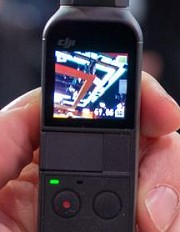
The display may seem a bit tiny at first but it proves to be very useful to control your recordings. It’s amazing how easy it is to operate the Osmo via the touch screen, despite its small display size:
Panning up/down: Pan the camera up and down by swiping vertically at the the far right edge of the screen. This works amazingly smoothly and precisely. You can also set Osmo to automatically pan up and down by simply tilting your hand.
Focus: Tap a spot on the display to manually set the focus at any time. The autofocus works fine in most situations, but in low contrast situations or with very diffuse subjects it is sometimes better to set it manually.
Change recording modes: Swiping from right to left on the display opens a menu where you can set the recording mode (video, photo, timelapse, panorama etc.).
Playback / delete files: Swipe from left to right to open the file menu where you can playback or delete already recorded videos and photos on the SD card.
Settings menu: Swipe from top to bottom on the display to get into the settings menu where you can format your SD card, set the white balance, image format and quality or the photo resolution. Unfortunately, not all settings of the Osmo Pocket are accessible here yet. To see all available settings you currently have to use the app (the Osmo saves the changes made in the app and can then be operated without the app). However, it is very likely that upcoming firmware updates will allow to change more and more settings on the Osmo Pocket itself. This is a pure firmware thing.
Tracking an object: Dragging a square around a person or object on the touch screen activates the Osmo Pocket’s automatic tracking mode. The camera then automatically smoothly follows the selected object.
The DJI Mimo App

Unfortunately DJI wasn’t aware that there are millions of Android devices out there with a Micro USB port isntead of an USB-C or Lightning connection. If you are one of the many millions of users who have an Android device with Micro USB port, an adapter is necessary (available for 5-10 USD on Ebay), which can then be plugged into the lower USB-C port of the Osmo. This works, but is not as comfortable as simple plugging the Omso into the side of your device. But there are already some 3D-printed solutions available on Thingiverse to compensate this.
As soon as the Osmo Pocket has been connected to a smartphone or tablet and is switched on, the DJI Mimo app launches automatically. The Mimo app is operated very similar to the DJI app for the Spark, Mavic or other DJI drones. The app’s UI is quite intuitive, so we won’t go into detail here. There are already lots of Youtube videos available that show how to use the Mimo app.
Using the app with the Osmo offers both, pro and cons in practice. Sure, the app has a much bigger screen instead of the small display. You can pan and tile the Osmo into all directions with the app’s virtual joystick and also change ALL the available Osmo settings – but it also makes the handling of the Osmo more cumbersome than simply filming from your hand.
UPDATE:
With the firmware update February 2019 almost all PRO settings (like ISO, shutter speed, color settings and much more) can now be done directly on the Omso Pocket without the need of the Mimo app, so the Osmo Pocket is now in no way inferior to a professional camera.
Whether you use the app or the Osmo alone just depends on the intended use. If, for example, you want to film a ride on your e-board, you’ll prefer to use the Osmo alone and simply film out of your hand. Filming with the app is recommended for more sophisticated photos (timelapse, special exposures, etc.), as the app also displays overexposed and underexposed areas, as well as a histogram. Also with timelapse shots, it might be better to first check the waypoints on a large screen before shooting for hours.
On the next page: Pro and Cons, Summary
Review: DJI Osmo Pocket
Content:
Page 1: Specs, Accessories, Activation
Page 2: How to use, Mimo App
Page 3: Pro & Cons, Rating
Page 4: Tips, Tricks und Mods
Page 5: Videos
| DJI Osmo Pocket & Accessories: |
|---|
| DJI Osmo Pocket 15% Off - Code: OSMO15 |
| ND Filter Set for Osmo Pocket |
| Osmo Pocket Tripod |
| Mini Tripod for Osmo Pocket |
| Skins / Decals for Osmo Pocket |
Osmo Pocket: The Pros
For us personally, the advantages of the Osmo Pocket clearly outweigh those of other “action cams”. But of course it depends on the intended personal use. As an advantage the following points are to be emphasized in any case:
Excellent video quality
The most important thing first and foremost: the video quality of the Osmo Pocket is outstanding and clearly beats even that of the Gopro 7. This is not surprising: on the one hand the Osmo has a mechanical gimbal as opposed to a digital image stabilization, on the other hand the Osmo Pocket films in full 4K resolution and with a fabulous data rate of up to 100 Mbps. This ensures razor-sharp, perfect video material.
Even with automatic settings, Osmo delivers really flawless video – no need to make cumbersome settings, or adjust the colors and contrast of the videos in post-production to get really great video footage. Even with the basic settings and in automatic mode, impressive videos can be produced under good conditions. DJI proves once again with the Osmo that they really know their way around camera technology and as far as pure video quality is concerned, the Osmo of the Gopro and most other current Action Cams clearly steals the show.
Handy size
If you already have a “normal sized” gimbal – for example for smartphones or action cams – the DJI Osmo Pocket will give you a lot of pleasure since you’ll appreciate this compact solution for sure. The Osmo Pocket is really the first 4K Gimbal that you don’t have to carry around in your backpack all the time or put it together before taking a shot. Simply take it in your hand (or leave it right there), switch it on, start filming. And that’s exactly how it has to be.
Charging during recording
Especially practical is that you can charge the Pocket at any time – even during recording videos. So even longer timelapse recordings are no problem. Since the built-in battery “only” has a capacity of 900mAh, the Osmo Pocket can be charged with a conventional 3600mAh Powerbank (7 EUR, Ebay) about three times. With an operating time of about 120-140 minutes per single battery charge, you get a total operating time of 6 hours then – and even charging via a solar USB panel would be possible.
The display
The bright display makes sure that you don’t have to film “blindly”. You see what you’re filming – and if you’ve had action cams without a display, you’ll definitely appreciate this feature, especially when adjusting the gimbal or focussing. After all, it can end up very annoying if you notice at home that you messed up all your videos or fotos. You won’t have to worry about such surprises with the Osmo Pocket because you can view your pictures and videos on the display at any time.
Operation
The operation of the Pocket using the touch display is very intuitive and can be done quickly by hand. After just five minutes, you’ll have understood how it works and know how to operate that tiny device. Thanks to the Pocket’s well thought-out touch menu navigation (you can quickly return to the camera image from anywhere by pressing the power button), an amazing number of settings can be made here, even though the Pocket only has two hardware buttons (which you don’t need to do so). There is no need to awkwardly use any hardware buttons dozens of times or spending much time to find setting XYZ in a camera’s poor LCD menu. You’ll definately appreciate the Osmo’s handy and simple to use touch screen.
Update: with the firmware update in February 2019, almost all PRO settings that could previously only be set via app can now be set directly on the Osmo. The app is no longer needed to do so, which makes the Pocket even more mobile and versatile. Just make sure you have the latest firmware installed on your Osmo.
Osmo Pocket: The Cons
Where there is light, there is also shadow – and the Osmo Pocket is not completely free of some disadvantages. However, if you feel the one or other point mentioned below as a disadvantage or not just depends on your personal needs:
No “real” action cam
Strictly speaking, the Pocket is not really an action cam – because those who like to film while skiing or diving, of course expect a waterproof and stable case in which the cam is safely stored. Such a case is available for the Osmo but has to be bought separately. If you can do without such a case (e.g. on excursions, hikes, on trips etc.) you will not miss it. The Osmo comes with a sturdy case for storage – but unfortunately it’s a storage case only, the Osmo has to be taken out of the case before filming.
Narrow FOV
Some users will miss a wide angle lens with the Osmo Pocket. At first glance, the quite narrow FOV of 80 degrees is rather suitable for selfies than epic landscape shots. But: for great wide-angle shots the Osmo also offers the automatic 3×3 or 180 degree panorama functions. And unlike cams with a wide FOV, there is absolutely no distortion or fisheye effect with the Osmo Pocket, which would be very noticeable when shooting near range objects or filming faces. It would have been nice if you could simply select this in the menu (Wide, Narrow etc.) as with the GoPro, but for us personally the only noticeable disadvantage of the narrow FOV is that you have to keep the Osmo a bit far away with Selfies if you don’t have very long arms.
Cumbersome activation
You only have to do this once and then you can film normally with your Osmo Pocket – but honestly, DJI: why annoying the user that already paid for his product? The fact that you have to activate a cam online to be able to film with it is just bizarre – and to close-out users with Micro USB ports is simply outrageous. After all: using a simple adapter solves the problem with the activation, even if it is unneccessarily annoying.
No Micro USB
The vast majority of Android users (and these are the vast majority of ALL smartphone users) currently still have a Micro USB ports. Only the gods know why DJI has completely ignored this fact. If you don’t want to do without using the Mimo App, you can rest assured: it also works with a USB-C to Micro-USB adapter, but it’s not as handy as simply plugging the Pocket into your smartphone’s side with the included sliding adapters.
Summary
From our side: a very clear recommendation for the DJI Osmo Pocket after all. Why? Because with its ultra-compact size it’s simply the first 4K 60 FPS gimbal solution you’d always want to take with you, unlike other gimbal solutions we’ve used so far. The Pocket also allows you to film inconspicuously, which is an advantage in many situations. With a video bitrate of 100 Mbit/s and rock-stable, shake-free videos, the Osmo Pocket’s video quality is beyond any criticism. Thanks to the mechanical stabilisation (as opposed to a purely digital one) you don’t give away a single bit of video quality. We would have liked to have had a bit more accessories included with the purchase – but honestly, the majority of users get along with what’s in the box.
Since the firmware update in February 2019, almost all PRO settings can now be set directly on the Osmo without using the Mimo app. This tiny camera is now in no way inferior to a professional camera: 4K videos, manual setting of ISO, shutter speed, white balance, various color profiles to choose from, timelapse, slow motion, panorama functions and more – and all that in a single, compact device!
On the next page: Tips, tricks and mods for the Osmo Pocket
Review: DJI Osmo Pocket
Content:
Page 1: Specs, Accessories, Activation
Page 2: How to use, Mimo App
Page 3: Pro & Cons, Rating
Page 4: Tips, Tricks und Mods
Page 5: Videos
| DJI Osmo Pocket & Accessories: |
|---|
| DJI Osmo Pocket 15% Off - Code: OSMO15 |
| ND Filter Set for Osmo Pocket |
| Osmo Pocket Tripod |
| Mini Tripod for Osmo Pocket |
| Skins / Decals for Osmo Pocket |
Tips, Tricks and Mods for the DJI Osmo Pocket
Skins & Decals
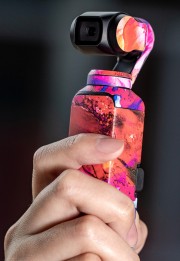
These original and colorful decals can be removed at any time without leaving any residue. They also serve another purpose: the 3M Scotchcal material protects the Osmo’s case from scratches, UV radiation and moisture.
Decals for the Osmo Pocket are available here
Manual gimbal adjustment
What many people don’t know: the gimbal of the Osmo Pocket can also be aligned manually instead of using the touch display. Simply grab it gently with two fingers and turn it to the desired position. Don’t worry: this won’t damage the gimbal in any way, because this is actually an intended feature. As soon as you grab the gimbal, the pocket “recognizes” that you want to adjust the gimbal and it can be guided smoothly into any desired position – that’s very practical!
Focussing objects
The automatic focus of the Osmo Pocket works very well in most situations – but sometimes you want to focus on a specific object that is placed off-center or has a low contrast. This is done by simply tapping on the desired position of the image on the touch screen. The Osmo Pocket then takes this position as a reference for automatic exposure and focusses on this spot. This is especially helpful in low-contrast environments or when the subject to focus is quite diffuse.
200 FPS slow motion
In the Osmo Pocket’s menu, the frame rate can currently be set to up to 120 FPS. This already allows quite respectable slow-motion shots (the higher the frame rate during filming, the slower the recorded video can be played later without unpleasant jerking effects). However, the Osmo even manages 200 frames per second. However, this setting is currently only available via the app.
Touch menu gotchas
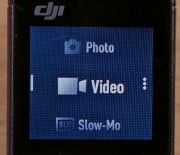
The white bar is not a scroll indicator as you would probably think, but indicates in which direction you’ll return to the main screen. The three points, on the other hand, indicate that there are further options besides a menu point which are accessible via a swipe gesture.
Panning the gimbal via touch screen
If you want to gently pan the gimbal up or down without the app, just tap on the right edge of the touch screen and then slowly move your finger up or down. This way the gimbal can be panned very precisely. A nice gimmick: while using this feature, a scale with an arrow appears on the opposite side of the display showing how far the gimbal is pointing up or down. There you can also read where the gimbal’s center position is. The gimbal can also be quickly returned to the center position at any time by tapping the hardware power button twice.
Time lapse with additional waypoints
If you start a time-lapse recording via the touch menu of the Osmo Pocket, two waypoints are available: the start position and the end position. Both can be selected by turning the gimbal manually to one position and then to the other. During time-lapse recording, the Osmo then automatically moves (rotates) from the start position to the end position. But there are also automatic time-lapse recordings with up to four waypoints possible – for this you have to use the Mimo app. Here you can currently enter up to four waypoints for the automatic pan.
Portrait mode
If you would like to take a portrait photo, you just need to hold the Osmo Pocket horizontally. It will then automatically switch to portrait mode. Thank God this only works with photos at the moment, not with videos – so you don’t have to be afraid to produce any portrait mode videos.
Film at 100 Mbit/s
The Osmo’s highest bit rate of 100 Mbit per second is currently only available in 4K 60 FPS mode. The highest bitrate for the currently selected video mode is obtained by selecting the “Superfine” option in the video menu of the Osmo Pocket. However, this option is not available for all selected resolutions. Note: activating the “Superfine” option will shorten the Osmo’s battery life and is also not always necessary, since extreme sharpness is not always intended in every situation.
Reduce video noise
Those who film at night or at low brightness situations should choose a resolution of 1080p instead of 4K resolution. Especially at higher ISO values, this distinctly minimizes the image noise that digital cameras like to produce in poor lighting conditions. In general, you should always choose the lowest possible ISO value in low light conditions, because the higher this value is set, the stronger the video noise will be. In the automatic setting, the Osmo automatically jumps to correspondingly high ISO values. If you want to avoid this, use the Mimo App and switch to the “Pro” mode to manually select the ISO value.
Optimal sound quality
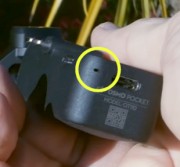
Of course, this also applies to the other microphone, which is located just below the touch display. For selfies, this is exactly the right place – but if you want to get the best sound quality with objects located in front of you, it is recommended to hold the Osmo Pockt with the touch display facing forward, so that the microphone points to the sound source. Since you cannot look at the display then, you should aim the gimbal manually in such a situation (simply grab it with two fingers and turn it to face the subject).
Charging Status LED
When charging, the small green LED of the Osmo Pocket flashes. As long as the LED keeps flashing, the Osmo is charging. However, the flashing of the LED also has a certain meaning and indicates the current charge status of the battery:
| LED | Charge Level: |
|---|---|
| Blink 1x | 0-24% |
| Blink 2x | 25-49% |
| Blink 3x | 50-74% |
| Blink 4x | 75-99% |
| 6 seconds green, then turns off | 100% |
Mini Tripod, Gopro Adapter
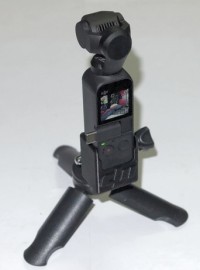
Especially for timelapse shots – or if you don’t want to hold the Osmo Pocket in your hand while filming yourself from a certain distance – a handy mini tripod is recommended. This tripod weighs only a few grams and fits in every pocket. Since the Osmo Pocket unfortunately has no tripod thread, it is recommended to choose the Gopro version of this tripod. You can then use the above mentioned Gopro adapter to attach the Osmo to the tripod.
Modded Case & Gimbal Cap
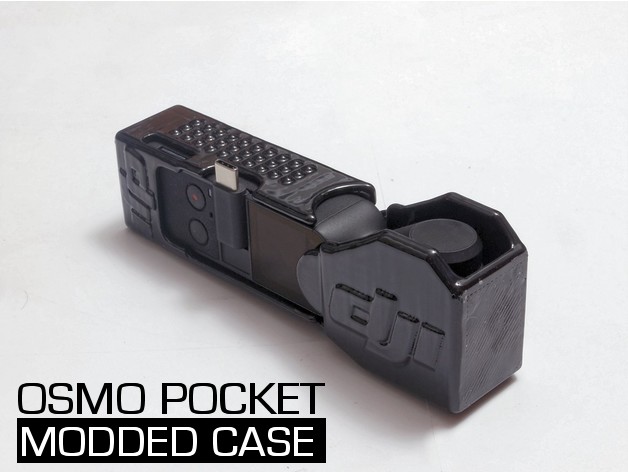
The original case of the Osmo Pocket is very stable and stylish, but has a disadvantage: you can’t film while the Osmo is in it and have to remove it first. More practical is a modded case, which consists of two separate pieces: a protective cover for the body of the Osmo and a gimbal cap. The gimbal cap can be removed quickly while the body of the Osmo stays permanently protected from scratches. In addition, the protective cover always offers a good and firm grip thanks to an anti-slip texture. The Mod Case also has a practical Gopro connector, with which the Osmo can be attached to a conventional Gopro Mount.
This 3D-printable Osmo Pocket Mod Case can be downloaded for free on Thingiverse.
On the next page: Videos (comparison Osmo Pocket with GoPro 7 and others)
You think this article raised lots of questions? Or you're interested into this topic and would like to know more about? Want to express your personal oppinion? Then feel free to drop a comment here.
Review: DJI Osmo Pocket
Content:
Page 1: Specs, Accessories, Activation
Page 2: How to use, Mimo App
Page 3: Pro & Cons, Rating
Page 4: Tips, Tricks und Mods
Page 5: Videos
| DJI Osmo Pocket & Accessories: |
|---|
| DJI Osmo Pocket 15% Off - Code: OSMO15 |
| ND Filter Set for Osmo Pocket |
| Osmo Pocket Tripod |
| Mini Tripod for Osmo Pocket |
| Skins / Decals for Osmo Pocket |
Osmo Pocket Test Videos
Osmo Pocket VS GoPro Hero 7 Comparisons
DJI Mimo App in Detail
View PagedView all articlesArticles in this category
Recent Comments
Leave a Reply
You must be logged in to post a comment.





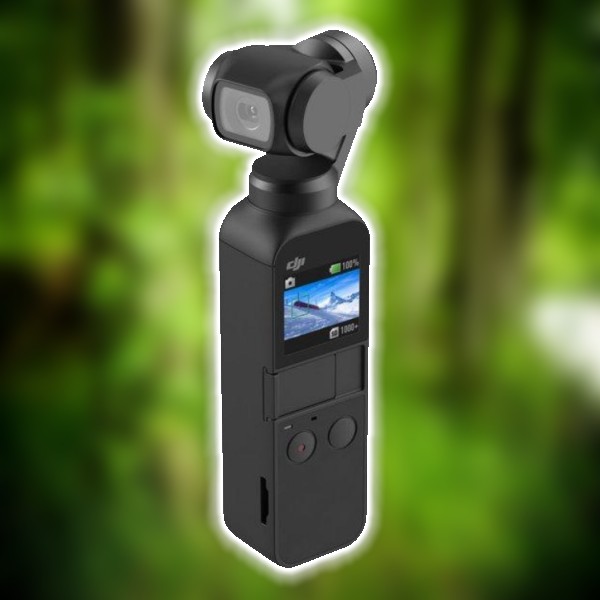
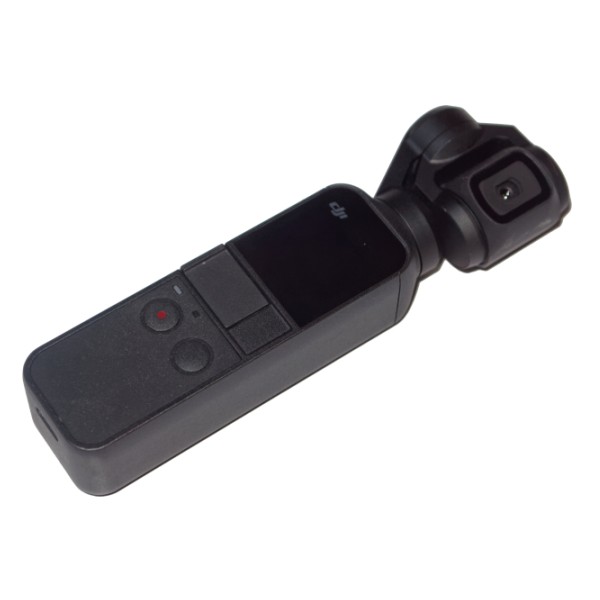

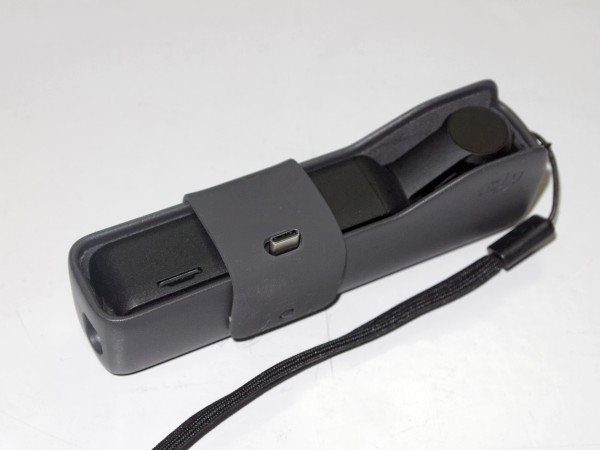
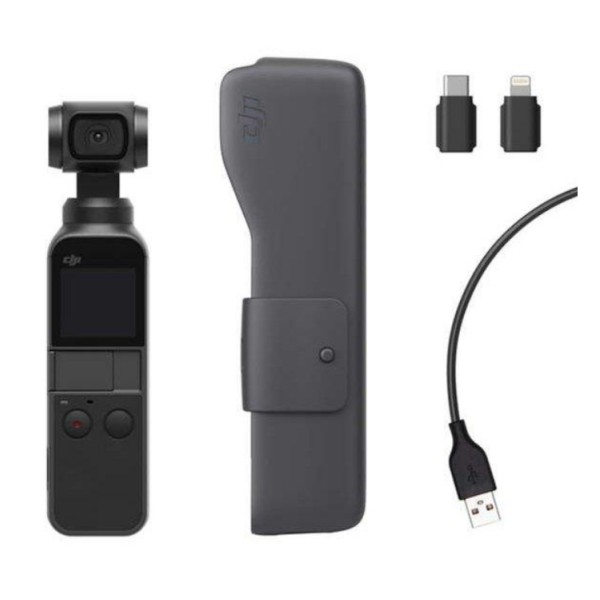
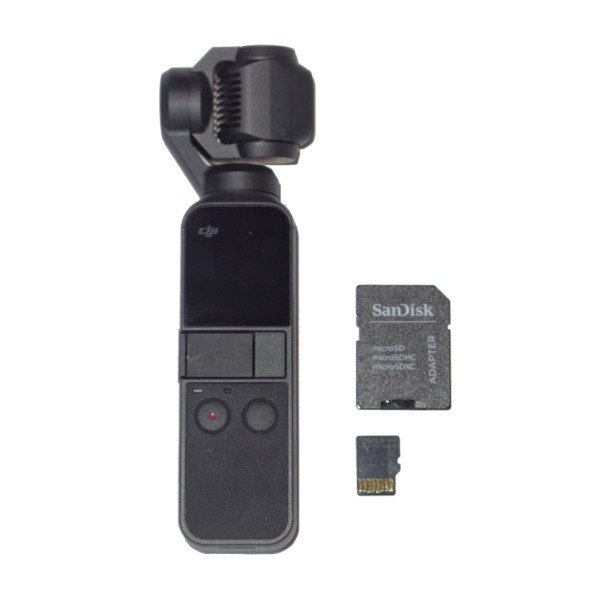
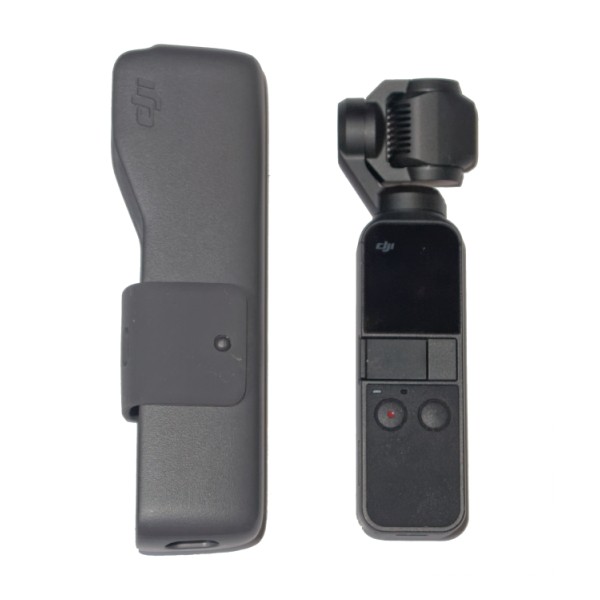
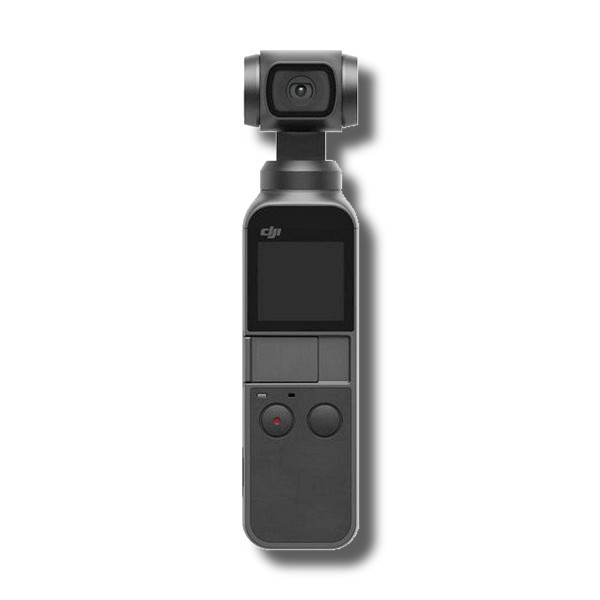
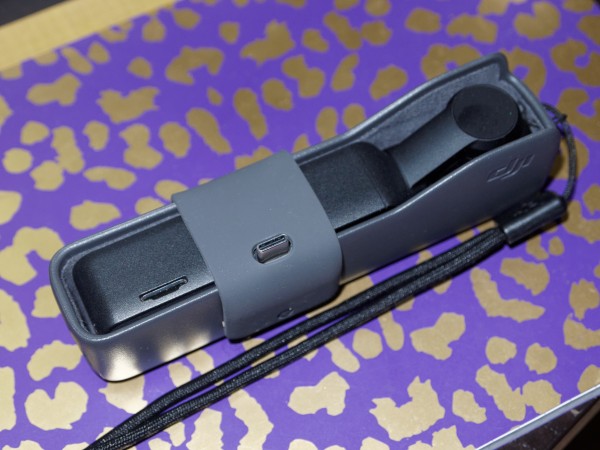
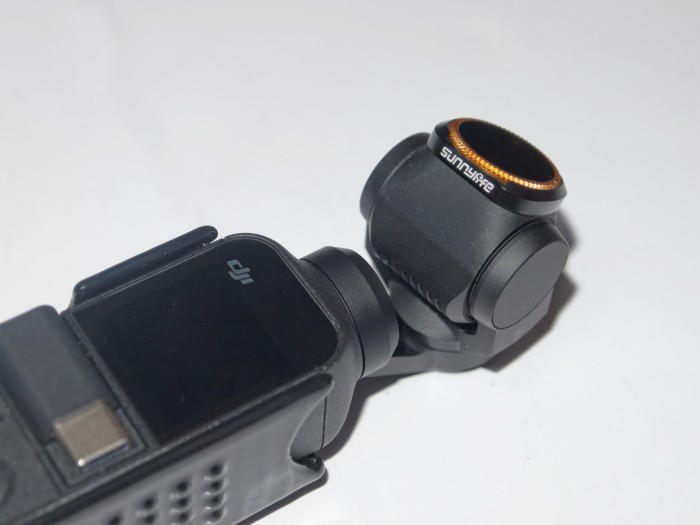


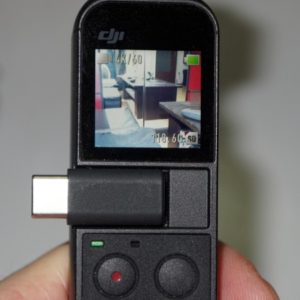



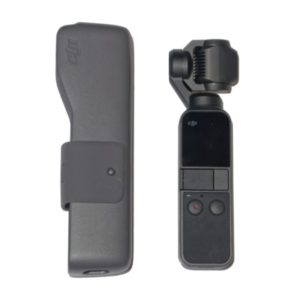




 Author: Mike vom Mars
Author: Mike vom Mars SHIRTS & HOODIES
SHIRTS & HOODIES 








































Hallo
Gefällt mir sehr gut der Bericht.
Ich habe jedoch eine Frage.
Welche FPS Einstellung würdest Du empfehlen, bei 4K 60, oder? Und wieviel FPS bei full HD?
Vorab vielen Dank
Dirk, das ist eigentlich eine Frage des persönlichen Geschmacks. Ich persönlich bevorzuge 60 FPS, da man hier das Videomaterial später auch in moderater Zeitlupe laufen lassen, also etwas langsamer abspielen kann, ohne das es zu ruckelig aussieht. Ausserdem ist das Videobild so aufgrund des schnellen Shutters gestochen scharf, so das man auch einzelne Standbilder verwenden kann. Schwenks sind mit 60 FPS schön flüssig und butterweich.
Andere bevorzugen aber 24 FPS. Das wirkt "kino-mässiger" (Kinofilme werden meist in 24 FPS gedreht) und hier ist dann auch die Belichtungsdauer (Shutter) etwas länger, wobei Bewegungen in den einzelnen Frames etwas verschwimmen (Motion Blurring). Eben wie in Kinofilmen auch. Das Motion Blurring kann man durch die Verwendung von ND Filtern sogar noch verstärken, wenn man es möchte. Bei Schwenks sollte man dann aber etwas langsamer rangehen, um Ruckler und verschwommene Objekte zu vermeiden.
Hallo !
Welche Einstellungen würdest du empfehlen , wenn ich im Sommer nach Asien fahre und da nur schöne Aufnahmen machen will.
Danke sehr!
Gruß
Zsolt
In den meisten Fällen ist die Automatik die richtige Wahl – der Pocket macht das schon recht gut. In speziellen Situationen (z.B. bei Nacht) kann man auf manuelle Einstellungen wechseln, sofern man sich mit Belichtungszeiten usw. auskennt.
Wenn dein Zielgerät ein 4K-Monitor ist, empfiehlt es sich, in 4K zu filmen. Wenn dir Full HD aber reicht, filme lieber in 1080p, das schafft deutlich mehr Platz auf der SD-Karte und der Akku reicht um ein Vielfaches länger.
Guten Tag,
was bewirkt die Einstellung Glamour Effekt unter den Fotoeinstellungen?
Danke Gruß
Thorsten
Thorsten, der Glamour-Effekt verschönert Selfies. Die automatische Gesichtserkennung des Pocket lässt Haut und Gesicht dann besser aussehen – vorteilhaft, wenn man sich gerade mal nicht rasiert hat 😊
Hallo !,
wenn ich mit der Mimo App einen Clip erstellen möchte, kann ich da auch Bilder/Videos die mit dem Iphone gemacht worden sind einfügen ?
Danke
Gruß Henrik
Das kann ich dir leider nicht beantworten, da ich dieses Feature nie nutze und zum Editieren meiner Aufnahmen einen "richtigen" Videoeditor vorziehe.
Hier gibt es Infos zum Story Mode (aber leider nichts über das Einfügen eigener Photos):
https://store.dji.com/guides/osmo-pocket-story-mode/
Kann ich meinen DJI- Osmo Pocket über einen Adapter(HDMI) direkt an einen Flat TV anschließen? Welcher Adapter ist kompatibel?
Soweit ich weiss, geht das mom. nur über Bastellösungen wie z.B. den Cosmostreamer:
http://cosmostreamer.com/products/pocketosmo/diy/
Aber wozu sollte das gut sein? Man braucht doch nur ein Tablet oder Phone via USB anschliessen und kann sich dort in der App das Live Bild oder Aufnahmen auf einem grösseren Display ansehen. Unterwegs reicht das doch in der Regel völlig – oder einfach die SD-Karte aus dem Osmo nehmen und in den TV stecken.